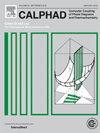Ti-Fe-Mo体系bcc相的相互扩散系数和原子迁移率
IF 1.9
3区 材料科学
Q4 CHEMISTRY, PHYSICAL
Calphad-computer Coupling of Phase Diagrams and Thermochemistry
Pub Date : 2025-04-15
DOI:10.1016/j.calphad.2025.102829
引用次数: 0
摘要
建立Ti-Fe-Mo体系的原子迁移率数据库是分析和模拟新型低成本医用钛合金扩散控制过程的基础。本研究在1273 K、1323 K和1373 K的退火温度下制备了12组扩散偶,退火时间分别为24 h、10 h和6 h。利用电探针微分析(EPMA)测量了扩散偶界面处的成分距离分布。采用数值反演方法计算高通量扩散系数,辅以Matano-Kirkaldy方法确定扩散偶交点处的扩散系数。两种方法的结果显示出强烈的一致性。基于精确的热力学描述和扩散系数,重新计算了Ti-Fe-Mo亚二元体系的动力学参数。利用HitDIC软件结合组分距离分布图,最终建立了该系统的原子迁移率数据库。此外,频率因子和活化能随组分的变化,可以用Arrhenius方程推导出来。本文章由计算机程序翻译,如有差异,请以英文原文为准。
Interdiffusion coefficients and atomic mobilities in the bcc phase of the Ti-Fe-Mo system
Establishing the atomic mobility database for the Ti-Fe-Mo system is essential for analyzing and simulating diffusion-controlled processes in novel low-cost biomedical titanium alloys. In this study, twelve sets of diffusion couples were prepared at annealing temperatures of 1273 K, 1323 K, and 1373 K, with annealing time of 24 h, 10 h, and 6 h, respectively. The compositional distance profiles at the diffusion couple interfaces were measured using an Electro Probe Micro-Analysis (EPMA). Numerical inverse methods were applied to calculate diffusion coefficients in a high-throughput method, complemented by the Matano-Kirkaldy approach to determine diffusion coefficients at diffusion couple intersections. The results from both methods demonstrated strong agreement. Based on accurate thermodynamic descriptions and diffusion coefficients, the kinetic parameters of the Ti-Fe-Mo sub-binary systems were re-evaluated. Using HitDIC software in conjunction with compositional distance profiles, the atomic mobility database for this system was ultimately established. Additionally, the frequency factor and activation energy, vary with composition, can be derived using the Arrhenius equation.
求助全文
通过发布文献求助,成功后即可免费获取论文全文。
去求助
来源期刊
CiteScore
4.00
自引率
16.70%
发文量
94
审稿时长
2.5 months
期刊介绍:
The design of industrial processes requires reliable thermodynamic data. CALPHAD (Computer Coupling of Phase Diagrams and Thermochemistry) aims to promote computational thermodynamics through development of models to represent thermodynamic properties for various phases which permit prediction of properties of multicomponent systems from those of binary and ternary subsystems, critical assessment of data and their incorporation into self-consistent databases, development of software to optimize and derive thermodynamic parameters and the development and use of databanks for calculations to improve understanding of various industrial and technological processes. This work is disseminated through the CALPHAD journal and its annual conference.

 求助内容:
求助内容: 应助结果提醒方式:
应助结果提醒方式:


